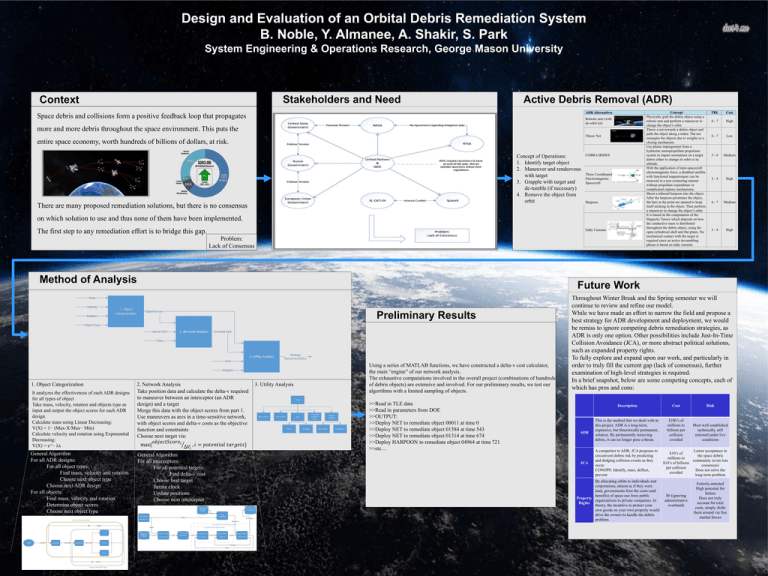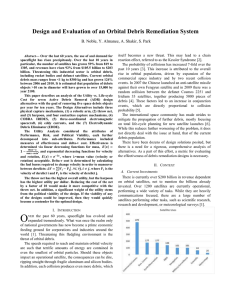Design and Evaluation of an Orbital Debris Remediation System
advertisement

Design and Evaluation of an Orbital Debris Remediation System
B. Noble, Y. Almanee, A. Shakir, S. Park
System Engineering & Operations Research, George Mason University
Stakeholders and Need
Context
Active Debris Removal (ADR)
Concept
Physically grab the debris object using a
robotic arm and perform a maneuver to
change the object’s orbit.
Throw a net towards a debris object and
pulls the object along a tether. The net
entangles the objects due to weights or a
closing mechanism.
Use plume impingement from a
hydrazine monopropellant propulsion
system to impart momentum on a target
debris either to change its orbit or its
attitude.
With the application of inter-spacecraft
electromagnetic force, a disabled satellite
with functional magnetorquer can be
removed in a non-contacting manner
without propellant expenditure or
complicated capture mechanisms.
Shoot a tethered harpoon into the object.
After the harpoon penetrates the object,
the bars at the point are opened to keep
itself sticking in the object. Then perform
a maneuver to change the object’s orbit.
It is based on the computation of the
Magnetic Tensor which depends on how
the conductive mass is distributed
throughout the debris object, using the
open cylindrical shell and flat plates. No
mechanical contact with the target is
required since an active de-tumbling
phrase is based on eddy currents.
ADR Alternatives
Space debris and collisions form a positive feedback loop that propagates
Robotic arm (with
de-orbit kit)
more and more debris throughout the space environment. This puts the
Throw Net
entire space economy, worth hundreds of billions of dollars, at risk.
Concept of Operations:
1. Identify target object
2. Maneuver and rendezvous
with target
3. Grapple with target and
de-tumble (if necessary)
4. Remove the object from
orbit
There are many proposed remediation solutions, but there is no consensus
COBRA IRIDES
Three Coordinated
Electromagnetic
Spacecraft
Harpoon
on which solution to use and thus none of them have been implemented.
The first step to any remediation effort is to bridge this gap.
Eddy Currents
Problem:
Lack of Consensus
Method of Analysis
It analyzes the effectiveness of each ADR designs
for all types of object
Take mass, velocity, rotation and objects type as
input and output the object scores for each ADR
design.
Calculate mass using Linear Decreasing:
V(X) = 1− (Max-X/Max− Min)
Calculate velocity and rotation using Exponential
Decreasing:
V(X) = e^− λx
General Algorithm
For all ADR designs:
For all object types:
Find mass, velocity and rotation
Choose next object type
Choose next ADR design
For all objects:
Find mass, velocity and rotation
Determine object scores
Choose next object type
Cost
6-7
High
6-7
Low
5-6
Medium
2-4
High
6-7
Medium
3-4
High
Future Work
Preliminary Results
1. Object Categorization
TRL
2. Network Analysis
Take position data and calculate the delta-v required
to maneuver between an interceptor (an ADR
design) and a target
Merge this data with the object scores from part 1.
Use maneuvers as arcs in a time-sensitive network,
with object scores and delta-v costs as the objective
function and constraints
Choose next target via:
𝑜𝑏𝑗𝑒𝑐𝑡𝑆𝑐𝑜𝑟𝑒𝑖
max{
∆𝑉𝑖 , 𝑖 = 𝑝𝑜𝑡𝑒𝑛𝑡𝑖𝑎𝑙𝑡𝑎𝑟𝑔𝑒𝑡𝑠}
General Algorithm
For all interceptors:
For all potential targets:
Find delta-v cost
Choose best target
Iterate clock
Update positions
Choose next interceptor
3. Utility Analysis
Using a series of MATLAB functions, we have constructed a delta-v cost calculator,
the main “engine” of our network analysis.
The exhaustive computations involved in the overall project (combinations of hundreds
of debris objects) are extensive and involved. For our preliminary results, we test our
algorithms with a limited sampling of objects.
>>Read in TLE data
>>Read in parameters from DOE
>>OUTPUT:
>>Deploy NET to remediate object 00011 at time 0
>>Deploy NET to remediate object 01584 at time 543
>>Deploy NET to remediate object 01314 at time 674
>>Deploy HARPOON to remediate object 04964 at time 721
>>etc…
Throughout Winter Break and the Spring semester we will
continue to review and refine our model.
While we have made an effort to narrow the field and propose a
best strategy for ADR development and deployment, we would
be remiss to ignore competing debris remediation strategies, as
ADR is only one option. Other possibilities include Just-In-Time
Collision Avoidance (JCA), or more abstract political solutions,
such as expanded property rights.
To fully explore and expand upon our work, and particularly in
order to truly fill the current gap (lack of consensus), further
examination of high-level strategies is required.
In a brief snapshot, below are some competing concepts, each of
which has pros and cons:
ADR
JCA
Description
Cost
Risk
This is the method that we dealt with in
this project. ADR is a long-term,
expensive, but theoretically permanent,
solution. By permanently removing
debris, it can no longer pose a threat.
$100’s of
millions to
billions per
collision
avoided
Most well-established
technically, still
untested under live
conditions
A competitor to ADR, JCA proposes to
circumvent debris risk by predicting
and dodging collision events as they
occur.
CONOPS: Identify, react, deflect,
prevent.
By allocating orbits to individuals and
corporations, almost as if they were
land, governments foist the costs (and
benefits) of space use from public
Property
organizations to private companies. In
Rights
theory, the incentive to protect your
own goods on your own property would
drive the owners to handle the debris
problem.
Lower acceptance in
$10’s of
the space debris
millions to
community (even less
$10’s of billions
consensus)
per collision
Does not solve the
avoided
long-term problem
$0 (ignoring
administrative
overhead)
Entirely untested
High potential for
failure
Does not truly
account for total
costs, simply shifts
them around via free
market forces






